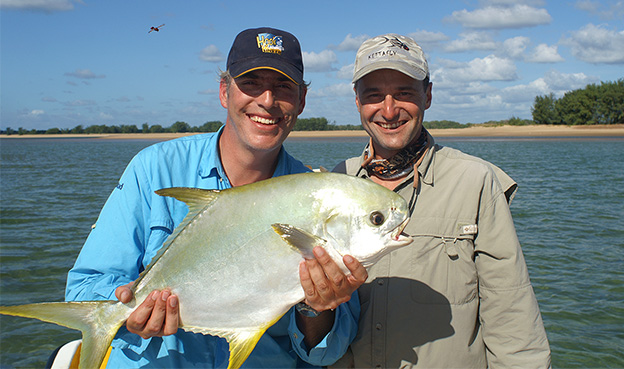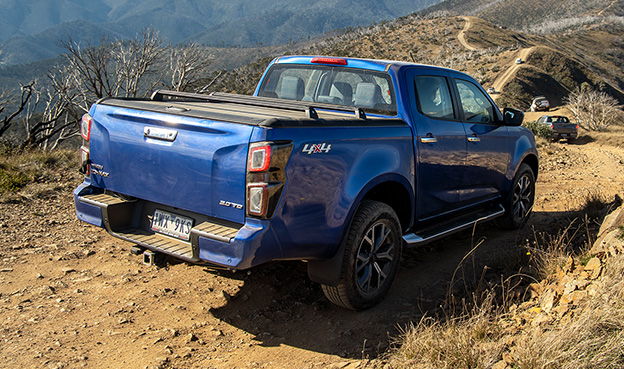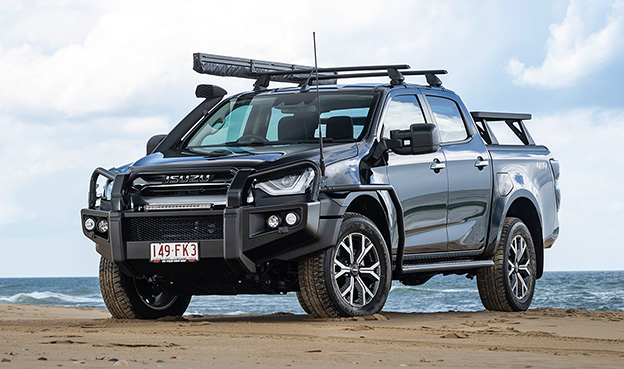

Consider this as you journey into the Daintree Rainforest: at 135 million years old, it’s at least 10 million years older than the Amazon (rainforest, not e-commerce website). For some perspective, the T-Rex went extinct 65 million years ago, and continental Australia separated from Gondwanaland about 10 million years later. The Isuzu D-MAX is 18. As you venture into this ancient landscape, you connect with an ecosystem that’s literally older than the ages of Australia and Isuzu UTE combined.
Freaky timelines aside, while it’s possible to experience this ancient landscape from the relative luxury of Daintree Village or Cape Tribulation, off-road enthusiasts will have their sights set on two iconic 4WD trails that cleave further into the forest for wilder adventures. Neither the Bloomfield nor the CREB track is very long, and both can be done in a day, although some noteworthy stops should be tempting enough to make camp at least once.

THE BLOOMFIELD TRACK
Perhaps one of the most controversial roads in Australia, the Bloomfield Track’s development began as soon as white settlers started logging the region in the early 1900s. That track was privately dozed in 1968 to improve access, before the Queensland government widened it again in 1984, joining it to the Mulligan Highway south of Cooktown. That development spurred widespread protests, eventually leading to the Daintree becoming a World Heritage-listed area.
Most people begin the Bloomfield at Cape Tribulation. The first bit of excitement is traversing Emmagen Creek, which is (usually) firm, shallow, and easy to cross. If you want to take a dip, a walking track heading west from the crossing takes you to Emmagen swimming hole. This stunningly beautiful waterhole is generally considered croc safe (but do your own due diligence). This is a clothing-optional swimming spot, so come as attired—or not—as you feel comfortable. If stumbling across leathery chaps splashing in the altogether isn’t your cup of tea, there’s a second safe swimming hole further on at Woobadda Creek.
In dry weather, the Bloomfield is more stunning than challenging as it sticks close to the coast and climbs over the Donovan and Cowie Ranges. But, unlike most roads with gradients of close to 30 degrees, there are no switchbacks in the climbs, so it feels like you’re crawling up sheer walls as you drive parts of the track. The steepest sections are concreted, but it is often closed after heavy rain because the road is too slippery (or Emmagen Creek is flooded).
As you come into Wujal Wujal-Bloomfield, only 30km but a world away from Cape Tribulation, seek out Wujal Wujal Falls. A place of significance to First Nations peoples, it’s a stunning, roaring site where torrents of water fall 40 metres. There’s no swimming, in part because of its cultural significance… and also because there are crocodiles. Nearby, there’s camping at Bloomfield Cabins and Camping, with access to the beach. Further north, Gap Creek Retreat opened to 4WD-only camping in 2020 and can be booked through Hicamp.

THE CREB TRACK
Where the Bloomfield is generally considered tame, the CREB can be one of Australia’s most challenging 4WD tracks. Although it’s only about 50km end-to-end, even a light sprinkling of rain can make it impassable.
The former Cairns Regional Electricity Board (CREB) built the track to service the powerlines that used to send electricity to Cooktown. Cape York local Tracy Sands, who literally wrote the book on exploring the area, Explore Cape York (2021), says the track’s difficulty is “overrated” when it’s dry. “It’s not as hard as the Old Telegraph Track if there’s no water on it,” she says.
When it’s wet, it’s not unusual for vehicles to become stranded waiting for the track to dry out and vehicle damage is common. PJ Wallace, a local farmer who’s lived on the track for nearly 30 years, and who runs the Local CREB Track conditions Facebook page, says, “I do it mostly in 2WD when it’s dry. It’s the road to town and it’s quite scenic with nice creeks. But in as little as an hour, it can go from being driveable in 2WD to easily coming to grief. It gets so slippery people can’t walk on it."
If the track has been dry enough to get dusty, just 5mm of rain can make it impassable. On the contrary, once the dusty top layer’s been washed away by heavier rain, Wallace says it gains some semblance of grip. That it’s often worse after light rain catches a lot of people out, but the track can dry out in as little as a few hours after light rain in the right conditions. “If it’s soaked in or after the Wet, it can take days,” says Wallace. “Sections that are heavily shaded can take at least two or three days to dry out.”
The council closes the road when it’s too wet, but Wallace warns that, “just because it’s open doesn’t mean it’s safe. For example, if it rains on a Friday evening, no one at council will update the road status until at least Monday.” Incidentally, Wallace’s Facebook page is often the most reliable guide for track conditions and he updates it regularly. “There have been heaps less recoveries and rescues since I started that page,” he says.

The CREB begins at Daintree Village. The first few kilometres are innocuous, but when you hit the dirt, lower your tyre pressure to between 15 and 20psi. The track winds upstream along the Daintree River through grassy farmland before the first challenge— literally crossing the Daintree River. It can be quite deep, so don’t plough straight over; instead, take a wide arc downstream to stay in the shallowest parts. And keep your eyes peeled.
“A big croc moves through the crossing regularly,” says Wallace. “It’s often more visible when there’s not a lot of traffic. But after that, there are no crocodiles until you drop back down into Wujal.”
The CREB is notorious for its narrowness, often with tropical ferns gently ‘caressing’ your paintwork on either side. There are plenty of places where two cars cannot pass each other.
Two of the biggest hills—McDowall Range up to the Telstra tower and Bob’s Hill—are the most notorious climbs and often where people come a’croppa. When it’s wet, it’s not unusual for steering wheels to become redundant and common accidents are the result of slowly sliding off the road… or even backwards down the hill you just failed to drive up.

Most people finish the track in half a day, but it can take far longer. Often stuck vehicles block the way for hours or days, and other times 4WDers turn around after the first hill exercising commendable caution.
Others miss out altogether because the track is closed when passing through. There’s nothing to do about that except approach the CREB with some flexibility in plans.
The best camping is at Yindilli Camping Ground, an Indigenous-run campsite on the northern part of the track. It’s $25 per vehicle per night. Sands recommends it.
“I love it there,” she says. “It’s perfect serenity and the walks up the waterfalls are sensational.”





